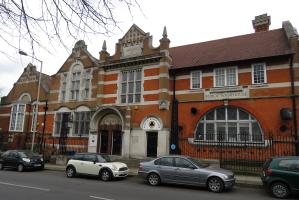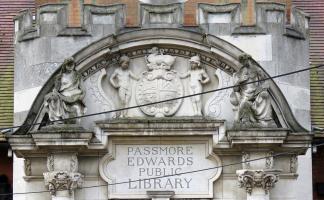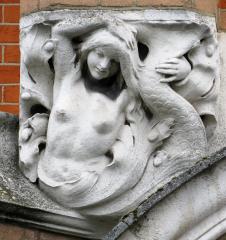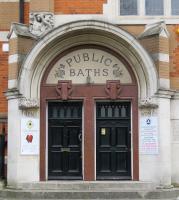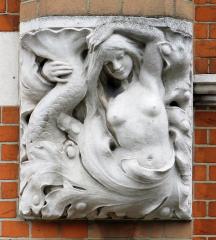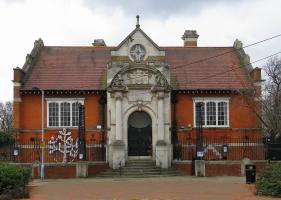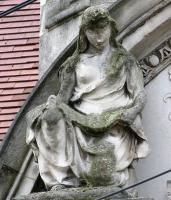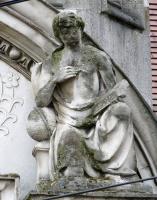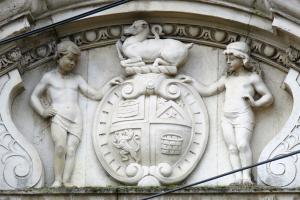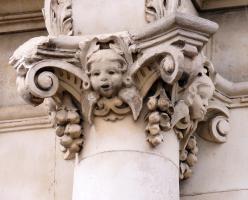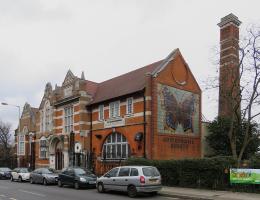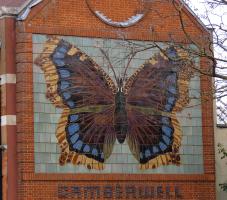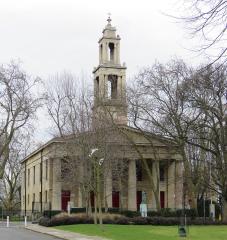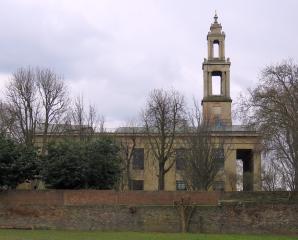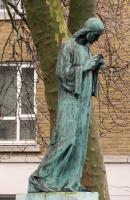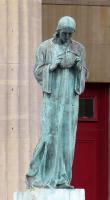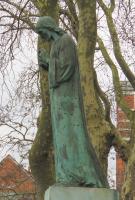Passmore Edwards Library and Baths, and St George’s Church, Wells Way, Burgess Park, South London
Passmore Edwards Library, Baths and Wash-House, Wells Way.
The Passmore Edwards Library, Baths and Wash-house, also called the Camberwell Free Library, is an interesting sculpturally-decorated building of Edwardian times. Public baths and wash-houses are now pieces of social history whose time has passed, and local libraries seem to be heading the same way, but Passmore Edwards libraries, or former libraries, are found in many parts of London, and this one is characteristic. John Passmore Edwards was a turn of the century philanthropist whose donations funded around two dozen libraries in London and others elsewhere, often built in a characteristic Queen Anne style (bright red terra cotta with pale stone dressings), with Arts and Crafts details, as here. There is a typically Edwardian skyline, with three gables to the pleasingly asymmetrical long side to Wells Way, and a variety of different types of window; around the corner, now facing into the park, is the large stone portico with pillars and round pediment. Because this is a library and not some grand town hall, the amount of sculpture is necessarily limited, but this is a good example of the minor sculptural adornment found on such buildings.
Wells Way bath-house entrance and sculpture, by Gunthorpe & Horsman, sculptors.
On the Wells Way side, the centre-right range has the entrance to the public baths, and includes above the ground floor a pair of corbels carved with mermaids. They are symmetrical, with identical poses, each with her tail curved round and upward, to be grasped by one hand, the other on her head. Around them swirl bladderwrack seaweed, rather like Acanthus leaves here, and these are almost but not quite symmetrical on the two corbels. The figures are charming, and nicely designed.
The main entrance round the corner has pillars to the sides of the round-headed doorway, holding up a rounded pediment without an entablature, and above, a castellated balustrade and a gable. The sculpture here consists of a coat of arms with two children as supporters in the pediment, two seated figures somewhat in front of the sides of the pediment, and carvings to the capitals of the pillars, as well as more minor adornment including the keystone and other leafy, scrolly designs.
Library entrance and figure sculpture.
What a difference the pediment makes – although the edge does not project that far forwards, the figures within it are in a good state of preservation, whilst the larger seated figures above the pillars are in an advanced state of decay, with faces having lost their features, hands with lost fingers, and other minor details gone entirely. They seem to be allegorical figures representative of Reading and perhaps Knowledge, or two aspects of Literature (if you like statues of this sort, see the Allegorical alphabet pages). The figure on the left as we look at the frontage is female, wearing a loose Classical drape leaving one breast bare, and holds a scroll across her knees at which her gaze would once have been directed. To the right is a male figure, also Classically draped with bare chest, not particularly muscular, and while the face is largely gone, we seem to have a youthful figure indicative of a young student rather than the typical athletic Greek figure. He has a thick book in one hand, and in the other, perhaps the remnants of a pencil, unless it be the callipers which would accompany the globe on which his elbow rests.
Within the rounded pediment, as noted, the sculpture is better preserved, and cleaned up. The central coat of arms has a substantial female deer seated upon it, and the supporters to left and right, figures of children, are delicately made with cherubic faces, though the little girl’s outstretched arm seems a little long for her age and sex. Note too the capitals of the pillars, somewhat damaged but still bearing several little heads from among the ornament, with hollow eyes and open mouths, an effective treatment (lots more pictures of pillar sculpture on this page).
Details of pediment sculpture and a carved pillar capital
A panel on the building notes the architects as Maurice B Adams and William Oxtoby – the latter was the borough engineer at the time the building was erected, and Adams was an architect responsible for several of the Passmore Edwards library buildings. The foundation stone was laid in mid-1901, and the date on the building above the entrance, when it was completed, is 1902.
There was a note of the building in the London Argus on 11 April 1903, which is available online, and this notes the other craftsmen and manufacturers involved with the building; there is Doulton tilework on the baths inside, and a note that ‘Messrs Gunthorpe & Horsman, of Camberwell New Road, were entrusted with the carving’, which would be the external sculpture we have noted above. They really are rather obscure and I am not aware of other extant architectural sculpture by them, though like as not there is some number of preserved works as yet unattributed to them.
There is an addition on the other short side of the building, where the wash-house is, a grand piece of tilework showing an enormous butterfly, after a local variety known as the Camberwell Beauty butterfly. Somewhat stylised, and with glowing colours, it was made by Doulton of Lambeth for Samuel Jones and Company, a stationers whose factory it adorned in Southampton Way, not far off, and whch was moved here after the premises were pulled down in the early 1980s.
Camberwell Beauty butterfly, tiles by Doulton of Lambeth.
St George Church, Wells Way
A few dozen yards along Wells Way from the Library and Bath-house is the former St George Church, now converted to flats but with the exterior preserved. Francis Bedford was the architect of this church – he designed several South London churches, including St Luke’s West Norwood, and Holy Trinity in Trinity Square, Borough, noted on this page. It was built with £5000 from the Waterloo Commission (thus called a ‘Waterloo Church’), added to the £13,000 raised from inhabitants of the new built area.
St George, Wells Way, a Waterloo Church by Francis Bedford.
The surviving exterior is impressive enough from a distance in winter, when the leaves of the trees do not hide it, with six fluted columns supporting an entablature bearing carved wreaths, with a blank pediment above – had the Waterloo Commission but found an extra £1000 it could have had some nice sculpture there. The square tower rises in open stages with pillars to a summit crucifix.
I do not know of any monuments which were inside, but a 1950s account describes the interior rather disparagingly as follows: ‘It cannot ever have been pretty; now, dirty and dank, with galleries far too high, with enough altar steps for St Peter’s and with a Red-Indian-pink chancel like two vast magnets added in 1893, it must be one of the least pleasing churches in London.’
Statue of Christ by a Danish Sculptor:
Arild Rosenkrantz's statue of Christ.
We do have one modern piece of sculpture, a bronze statue of Christ in front of the Church; he is shown as a thin figure, very thin, wearing a wide-sleeved robe down to the ground, in a thoughtful attitude with downcast head, hands held upwards and clasping his crown of thorns, walking forward with a leaning-forward posture somewhat reminiscent of the leaning forward Epstein statue of Jan Smuts in Parliament Square. It is an early 20th Century work, dating from 1919, a WW1 memorial, and interesting in that it is by a Danish sculptor and painter, Arild Rosenkrantz. Typical of the austere figural sculpture favoured by many after the First World War and through into the 1920s, before the Art Deco movement brought a new style of figure sculpture at the end of that decade.
Danish sculpture is rare in England, but there is one most famous sculptor whose work can be found - Caius Gabriel Cibber, best known in London for the large panel at the base of the Monument to the Great Fire, but whose various portrait statues and architectural sculpture may be found in various places across England. Among others, he has fine wooden statues of saints at the Danish Church, St Katherine's, by Regents Park. A later sculptor, also of great importance, was the Antwerp-born Peter Scheemakers, whose sculpture in Britain include the famous statue of Shakespeare in Westminster Abbey - he had been trained under the Danish sculptor J. A. Sturmberg. There is a Denmark Street in London, off Charing Cross Road, known for its specialist musical instrument shops, but named after Prince George of Denmark, husband of Queen Anne - there is a statue of him in Windsor, along with Queen Anne, on the front of the Town Hall. The Berkeley family were descended from the Kings of Denmark, according to a 17th Century monument to Lord John Berkeley in Twickenham Church. And in the early 19th Century, the Danish King’s Consul General in London, Henry Horneman, died and was buried in St Mark's Church, Kennington, where he has a memorial panel. And another, long vanished church in the City of London, St Martin Orgar, was named after its 10th Century benefactor, Ordgarus of Denmark - the little churchyard still survives by Martin Lane.
This page was originally part of a 'sculpture of the month' series, for May 2016. Although the older pages in that series have been absorbed within the site, if you would wish to follow the original monthly series, then jump to the next month (June 2016) or the previous month (April 2016). To continue, go to the bottom of each page where a paragraph like this one allows you to continue to follow the monthly links.
Go North and West to Walworth Road // or St Peter's Church, Walworth // or North and East to Bermondsey, St Mary's Church
Borough to Bermondsey: churches and sculpture // Other London sculpture
